
by Alex A. Kecskes
Summer’s finally here and you’re ready to invite friends, family and neighbors to your patio for a fun-filled BBQ. The last thing you need is bird poop all over your BBQ, patio cover, balcony and walkways. Or to have annoying birds dive bomb your gests and kids as they try to enjoy their outdoor summer treats.
Yes, there are bird poisons and you could whip out your trusty BB gun. But do you really want to subject kids and pets to such extreme, potentially hazardous measures? Also keep in mind that in many states and municipalities, it’s against the law to kill or harm certain birds. Banging pots and pans and shooting off firecrackers will scare birds away—but only for a little while. Unless you use permanent and effective bird control measures, they’ll come back in droves when they get a whiff of your outdoor cooking.
Fortunately, there are a number of effective bird proofing devices that will keep pest birds away from your patio and balcony. Measures you can employ without risking injury to kids, birds or pets. They include:
Visual Scare Deterrents. These are fairly economical and easy to attach to various areas of your balcony, patio, or gazebo. They include a variety of flash tape and reflective banners that reflect sunlight and crackle in the breeze. The audio/visual elements combine to create a distraction that makes pest birds feel uneasy. You can also get Bird Scare Balloons—beach ball sized bird deterrents emblazoned with large predator eyes. Birds really feel uncomfortable with these. Likewise for Bird Scare Diverters, which are bladder shaped deterrents that have a large eye on them. Remember that birds are not dummies, so you’ll need to move them around occasionally to prevent the little critters from getting used to them.
Bird Sonics. These time-proven bird deterrents can be discretely installed on patio covers, under eaves or and inside gazebos. They can keep pest birds away from large outdoor areas by emitting predator and distress calls that birds instinctively hate. They capitalize on a bird's innate fear of predators, as well as their acutely sensitive hearing (birds can process sounds in 1/200th of a second; humans process sounds in 1/20th of a second).
Sonic devices will guard your patio and balcony against pigeons, crows, starlings, swallows, gulls, woodpeckers, sparrows, grackles, cormorants and many other types of birds. One of the most effective sonic systems broadcasts the sound of Peregrine falcons (a pigeon's dreaded enemy) defending their territory. Other systems will deter starlings and seagulls with the sounds of predator hawks screeching and gulls under attack. Try to get sonic bird control systems that alter the pitch, frequency, timing and intensity of the sounds they emit. You don’t want pest birds to get used to hearing the same sound over and over. One highly regarded system emits distress and predator calls for as many as 22 types of birds. The calls are cycled through every fifteen minutes. One thing to keep in mind is that sonic bird deterrents will not harm birds, pets or humans. The sounds they emit are normal bird sounds.
Scarecrows. These ingenious devices are basically motion-activated sprinklers that give pest birds a hefty blast of water the second they enter the preset radius of protection. The sudden blast of water, alarming sprinkler sound and realistic looking bird head is enough to convince most birds that this is not a hospitable area. Scarecrows connect to almost any garden hose, yet they consume just 2 to 3 cups of water per blast. They cover about 1,200 square feet with a stream that reaches out 35 feet and 45 feet wide. They stand guard 24/7 for up to 6 months and deliver over 1,000 "firings" on a single 9-volt battery. You can even fine-tune their sensitivity and coverage distance. By the way, kids and dogs love to play with these devices.
Hawk Decoys. Get one or two of these decoys, strategically place them around your patio or balcony and pest birds will stay away. You’ll need to move them around and reposition them from time to time for best effect. Hawks are the natural predators of most pest birds and they hunt during the day. Be sure to get the most realistic looking bird available. And make sure they are quality fabricated of heavy-duty plastic so they stand up to the elements. Some decoys have a hollow bottom that allows them to be filled with sand for greater stability on windy days.
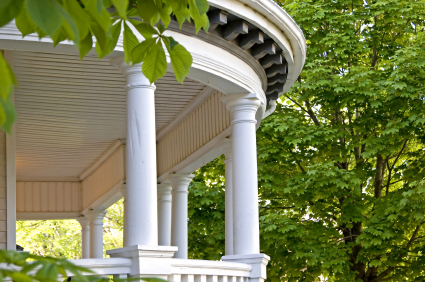
Many homes in the South and mid west are graced with beautiful wraparound front porches. They serve to draw friends and neighbors for long hours of conversation and relaxation. They’re also ideal for parties and other informal get-togethers.
Trouble is, these attractive gathering places also draw pest birds. Now, most people enjoy the sounds of birds in trees, but without proper bird control, birds can take over a veranda or front porch. These architectural features often have seemingly endless nooks and crannies where birds can roost and build nests. Nothing is more irritating than discovering bird droppings on a table, chairs or glider you’ve set out on the porch or veranda. Attract enough birds and you’ll face a daily cleaning chore getting rid of bird droppings.
If you’re like most nature loving people, you won’t want to harm these birds. You just want to keep them out of your front porch and off your tables and chairs. That means you naturally object to using bird poisons and other harmful bird deterrents. The good news is, there are a number of humane and highly effective bird deterrents you can use to keep birds away from specific areas of your home. These include:
No Nasty Nest
These hanging "twine" deterrents are ideal for keeping swallows away from common nesting areas. Birds of any kind will be reluctant to work their way past the twine strips and simply move on. If you've encountered swallow mud nests under the eaves and sides of your porch or veranda, this deterrent will keep them out. Every strip of No Nasty Nest features a self-adhesive back for quick installation on eaves, gables, entryways and other areas. Bird Slope
These angled, slippery PVC panels deny birds a place to land. They’re easily installed under eaves and are ideal for preventing swallows from building nests. Bird slopes can be installed on almost any surface using nails, screws or glue. Bird Slope comes in a 4-foot kit that contains two 2-foot long sections of slope, two end caps and one tube of glue. Bird slope is ideal for ledges up to 6 inches wide. It also comes in several colors to blend in aesthetically with your front porch or veranda.
Hawk Decoys
Decorative and functional, Red-Tailed Hawk decoys convince birds that their natural enemy is on the premises. Place one or two in “problem areas” and birds will stay away. Perfect for use in porches and verandas, Hawk Decoys are easily placed or hung in conspicuous areas to discourage pest birds. Birds will communicate with each other and spread the word that your porch or veranda is “occupied” by a predator. Be sure to choose a high quality decoy made of heavy-duty plastic, as it will remain realistic looking after years of outdoor exposure. For best results, be sure to move the decoy around often to ensure bids don’t get used to it.
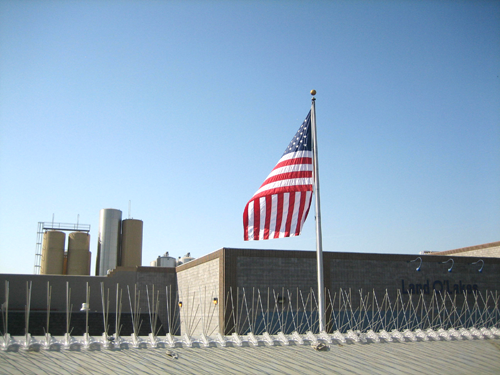
by Alex A. Kecskes
No matter how you feel about birds, when they invade your property en masse, they can be a real nuisance. Consider the damage just a few bids can do to your gutters, rooftop AC units, skylights, air vents and solar panels. Over time, their acidic droppings eat into these areas and devices, which can be very costly to repair or replace. Bird droppings left on your car, van, boat or RV can ruin the finish, especially if you wait too long to wash off the droppings.
There’s also the problem of bird nests and nesting debris, which can cause fires when they are built too close to any electrical device, exterior wiring or light fixture.
Finally, if you fancy eating outdoors, there’s the problem of diseases that pest birds carry—they can transmit any of 60 known diseases. Unless you control pest birds with bird guards or bird barriers, they will land on tables, chairs, BBQs awnings, pool ledges and spa areas. And every time they do, there’s the potential for them to drop a disease carrying “load.”
The solution, of course, is to install bird guards and bird barriers on your property. Two of the most popular bird control devices that fall into these categories are Bird Spikes and Bird Netting.
Bird Spikes Won’t Let ‘em Land
Whether you get stainless steel spikes or plastic, these deterrents are humane and highly effective. Both are easy to install and essentially maintenance free. The plastic bird spikes cost a bit less and come in 3-, 5- and 7-inch widths and two-foot spike strips. A single row of bird spikes usually covers a 7-inch wide area. The best plastic spikes have a flexible base that adapts to curved surfaces. Each spiked strip comes pre-drilled with holes along the base. The strips can also glued in place by using a glue trough at the base of each spike strip. Concerned about how bird spikes will look on your property? Not to worry. They now come in a full range of colors--including white, tan, gray, black, brown, brick red and even crystal clear. Custom colors are also available.
Create a Bird-Proof Barrier with Bird Netting
Bird Netting creates a barrier that blocks out most pest birds. It can keep everything from sparrows to pigeons from invading the nooks and crannies of your property. What’s more, like bird spikes, netting is a humane bird deterrent that won’t harm birds.
For bird netting that lasts, opt for Heavy-Duty polyethylene Bird Netting. It’s made from a U.V. stabilized mesh and comes in various sizes and custom cuts. The key here is to choose the right mesh size for the pest bird you’re having problems with. The three most popular mesh sizes include 2-inch mesh, 1 1/8-inch mesh, and 3/4-inch mesh.
The most rugged netting is ISO 1806 protocol mesh tested, flame resistant and rot- and waterproof. This durable netting consists of 6 monofilaments, each12/1000s of an inch thick. The monofilaments are twisted together to create a tough twine with 160-200 twists per meter. This high quality bird proof netting is frequently specified by architects.
To get the most deterrent effect out of bird netting, you must install it properly. Before installing Heavy Duty Bird Netting, thoroughly clean the area of bird droppings, nesting materials, loose rust, peeling paint or other debris. Improperly installed netting will sag or droop, leaving gaps that birds can work through. The one thing to remember here is that pest birds can be very resourceful when it comes to sneaking through netting. For best results in large installations, cables should be set up around the area and the net should then be attached to this cable.

by Alex A. Kecskes
If your driveway and parked cars are always covered with bird droppings, you need some serious bird control. If your weathervane has been stuck in the same position for the last 5 years, you need some major bird barriers. If that brand new garage door you just installed is already covered with bird poop, it’s time for you to get rid of birds.
Keep in mind that bird droppings can eat into and permanently mar most materials. That includes metal or wood siding, the paint on your car, boat or RV, and even that fancy stonework that gives your home such character. Yes, over time, bird droppings can cause even stone to crumble. And lest we not forget the damage bird droppings, nests and debris can cause to your AC units, solar panels, dish TV antennas, rotating rooftop vents and skylights. It all adds up to one big costly headache.
You’re probably thinking that you can just shoo them away with noisemakers or maybe take a pot shot at them with your BB gun. Not a good idea. BBs bounce all over the place and crack windows and strike unintended victims like dogs and (heaven forbid your kids). Noisemakers are just temporary. Birds always come back. What to do?
Fortunately, there are a number of bird barriers you can use to get rid of pest birds. Here are three of today’s most popular bird control solutions:
Lightweight Plastic Bird Netting
Easy to install and handle, this netting denies pest birds access to all those safe little nooks and crannies on the front of your home—places where they can land, build nests and perch before they attack your car, boat or RV. This bird netting comes in several mesh sizes to block out pigeons, sparrows, starlings, seagulls and other birds. One manufacturer offers netting in a full spectrum of colors to blend in with your home’s color scheme.
Sonic Bird Deterrents
These devices emit distress and predator calls that make birds too nervous to hang around your home. Some devices broadcast the sound of Peregrine falcons (a pigeon's dreaded enemy) defending their territory. Others emit the sounds of predator hawks screeching and gulls under attack. One of the most versatile sonic bird deterrents generates distress and predator calls for 22 different types of birds. By they way, these sounds resemble natural birdcalls to the human ear, so they won’t bother you, your neighbors or your pets.
Red-Tail Hawk Decoys
Most birds fear hawks—especialy Red Tail Hawks. That's why a realistic looking hawk decoy can keep birds away from your front porch or driveway. The point is to get a quality made hawk decoy that looks real and stays looking real after several rainy seasons and hot summers. Just remember, most birds won't be fooled for long, so you'll need to move these decoys around every week or so.
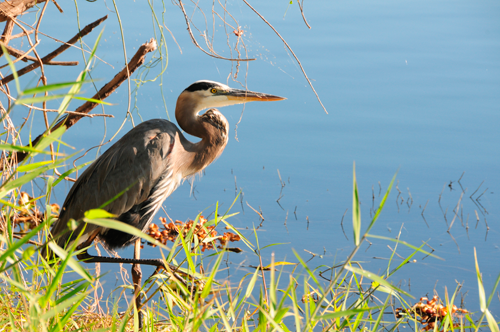
by Alex A. Kecskes
If you own a home near the ocean, river, pond, or lake, you may have had a run in with blue herons. These tall, light blue-grey birds have long black legs, pointed beaks, black bellies, and a black stripe along their white heads.
While they may be beautiful to look at, they can present a nuisance to your property. If you have a Koi pond, for example, you and your Koi may not be too happy to see them. For in addition to amphibians, invertebrates, reptiles, birds, and small mammals, blue herons enjoy feasting on fish.
If blue herons are giving you the blues, here are some humane and effective bird deterrents the pros use:
Bird Spiders
Like most birds, blue herons don’t like spindly things that can strike their legs as they attempt to land. Bird Spiders have long tentacles that whip erratically in the breeze to make birds too nervous to land on rooftops or fence lines. Bird spiders are easy to set up on just about any even surface. The devices come in 2-, 4-, 6- and 8-foot diameter arm lengths to create ever widening zones of deterrence. The best bird spiders come with a glue-on base, so you can easily attach them to most surfaces.
Plastic Bird Netting
An easy-to-handle and install bird deterrent, Plastic Bird Netting creates a physical barrier that will keep blue herons from specific areas of your home. The netting is typically sold in two roll sizes: 14 x 100 feet and 14 x 200 feet. You’ll want a relatively large mesh to block out herons. You’ll also want to invest in high quality, durable, U.V.-protected polypropylene netting, which is strong, light and virtually invisible. Nowadays, bird netting even comes in various colors to blend in with your home.
Solar-Powered Bird Repellers
Equipped with motor-driven “arms” that spin around continuously at 30 RPM, Solar-Powered Bird Repellers make it really rough for herons to land anywhere near them. You can easily position these repellers wherever herons gather most often. The best bird repellers come with adjustable arms that protect up to a 5-foot diameter area. And while they are solar powered, the best devices will also run at night or on overcast days, since they can store the sun's energy for later use.
Scarecrow Bird Deterrents
A silent sentry that springs to life the second a blue heron enters its radius of protection, Scarecrows do a convincing job of keeping birds away from your home. The motion-activated devices greet herons with a harmless water blast, startling sprinkler sound, and realistic looking bird-like moving head. Scarecrows connect easily to your average garden hose and will protect a 1,200 square foot area that extends 35 feet out by 45 feet wide. The best scarecrows will deliver up to 1,000 "firings" on a single 9-volt battery, and you can adjust their sensitivity and range.
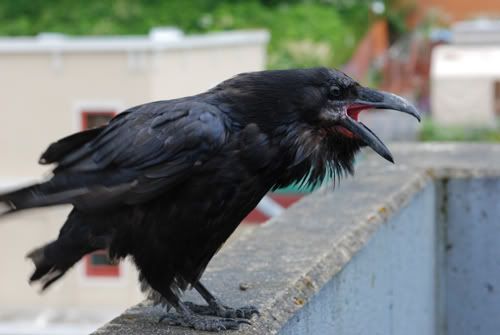 by Alex A. Kecskes If you’ve been invaded by crows, you know the damage they can do to your garden. When they’re looking for worms or nightcrawlers, they can dig dozens of holes in your lawn in just a few minutes. Crows can also damage your prized flowers. And they can be extremely noisy, even in small flocks. New research has shown that crows are among the most intelligent animals on the planet. They can recognize individual human faces and pick them out of a crowd. They will also work together to defend their territories and use “spotters” as lookouts to warn the flock of impending danger. Without effective bird control, they’ll quickly ruin your garden. If your thinking of shooting or poisoning them, crows are protected by federal law. While they can be hunted in certain states during specific times of the year, it’s best to check with your local fish and game department before attempting to shoot crows, or you could be in violation of the law. Of course, unless you live in the wide open country, with no kids or pets around, these draconian measures are too dangerous and impractical. The best way to keep crows out of your garden is to use the bird control devices today's professionals use. Here are three suggestions: Sonic Bird Deterrents If you have a large garden, Sonic Bird Deterrents will deter crows from a wide area. They work on a bird’s psyche by emitting pre-recorded distress and predator calls. Crows will react to these sounds and avoid your garden. If your garden is also being attacked by other birds, you might want to invest in the system that emits distress and predator calls for 22 different species of birds. This system will cover an entire acre and you can program it to turn on or off at night. Bird Spiders Ideal for protecting specific areas of your garden, Bird Spiders have long spindly legs that whip about threateningly in the breeze to discourage crows from landing. Place one or two on a pedestal in your garden, and crows will avoid landing anywhere near them. Bird spiders come in several arm lengths to offer wider and wider areas of protection. Scarecrows Using a motion-activated sensor to detect any bird’s approach, Scarecrows deliver a harmless but quite convincing blast of water to keep crows out of your garden. The devices connect easily to any standard garden hose and will protect a 1,200 square feet area (or a 35-foot by 45-foot wide swath). You can also adjust the sensitivity and blast radius to you specific needs. Scare Balloons These balloons are covered with a large eye, and will bob and weave in the breeze to appear lifelike and intimidate crows. The balloons can be attached just about anywhere, but should be moved around often—remember, crows are extremely intelligent.
 By Alex A. Kecskes Pest birds can be a huge problem when they congregate and nest in airport hangars. Without effective pest bird barriers to exclude them, hangar operators spend millions of dollars every year in maintenance and cleanup costs. Once pest birds invade a hangar, they settle in, make themselves at home, and seldom leave on their own. These birds can create considerable damage to aircraft and exposed aircraft engines and assemblies with their nesting materials and droppings. The acidic chemicals in droppings can eat into metal, plastic and rubber surfaces, causing long-term damage that may cause engines and hydraulic systems to fail--even in flight. Bird nests and droppings can also clog gutters and down pipes. Fecal matter sucked into grilles, ducts and vents can damage expensive AC systems. Bird droppings left to gather on hangar floors, entrances and ladders could create dangerous slip-and-fall hazards and result in a costly legal liability. The right kind of bird barriers can reduce or prevent these problems. Pest bird droppings and nesting materials also pose a considerable health hazard, carrying and transmitting any of 60 known diseases--including Salmonellosis and Ornithosis, which is similar to viral pneumonia. In addition, bird droppings and nesting materials contain insects and mites, which can also damage aircraft and delicate assemblies. Fortunately, there are effective and humane bird barrier products one can install to keep pest birds out of aircraft hangars.
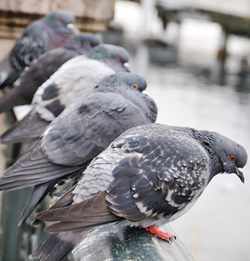 by Alex A. Kecskes Homeowners, is your patio being rained on by bird droppings? Do you find yourself washing bird droppings off your BBQ every week? Are your rain gutters clogged with bird nests causing water to always overflow into unwanted areas? What about your pool or spa? Do friends and family avoid it because of bird droppings in the water? If the answer is yes to any one of these questions, it's time you looked into a pest bird guards. Boat owners, is your pride and joy covered with bird droppings? Does your beautiful blue canvas boat cover rip due to hardened bird poop? Are your antennas and masts covered and jammed up with droppings? Do people slip and fall on the slippery poop left by birds as they move about your vessel? If so, you need some serious pest bird guards. Property managers, are pest birds destroying the businesslike atmosphere you've worked so hard to create. Are your air conditioning units and rooftop ventilators grinding to a halt? Are your solar panels and security cameras plastered with poop? Is your outdoor eatery losing customers due to bird droppings on tables and chairs? If so, you know what you need to do--get some bird guards! If you run a day care center or school, is the outdoor play area covered with disease carrying bird poop? Are the outdoor lunch tables splattered with bird droppings? If so, read on. You need some pest bird guards ASAP. Fortunately, for all those who have been putting up with pest birds, there are many highly effective pest bird guards to choose from. These are readily available, easy to install and safe for birds and people.
|








 RSS Feed
RSS Feed